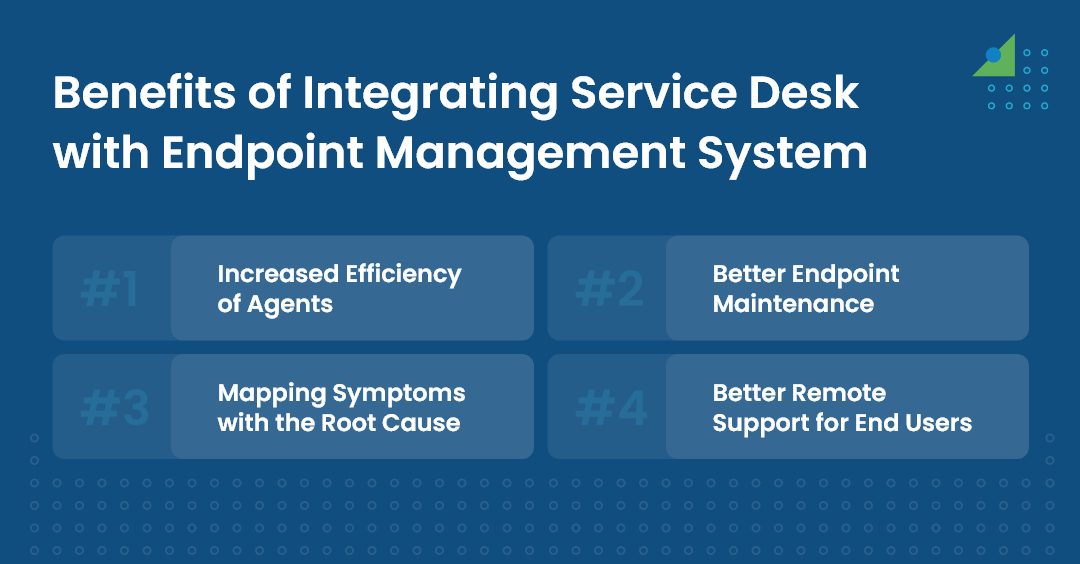As organizations continue to embrace digital transformation, IT support becomes increasingly crucial in ensuring smooth operations and user satisfaction.
The quality of service delivered by the service desk is directly linked to its value within the organization.
Modernizing service desks is highly essential as businesses transition to cloud infrastructure and embrace AI-powered automation.
One strategic step in this modernization journey is integrating a service desk with an endpoint management system.
By breaking down siloed operations and fostering collaboration, this integration brings numerous benefits that enhance user satisfaction and optimize IT service delivery.
This article will explore four key advantages of integrating a service desk with an endpoint management system, offering insights into how this integration can revolutionize IT operations.
4 Key Advantages of Integrating a Service Desk with an Endpoint Management System
1. Increased Efficiency of Agents
One of the primary benefits of integrating a service desk with an endpoint management system is the improved efficiency of IT agents.
Automating the linkage between user data and their associated devices allows technicians instant access to comprehensive information when a ticket is raised.
This seamless visibility eliminates time-consuming information requests and empowers technicians to resolve tickets faster.
For example, when a user reports a laptop booting problem, the integrated system will provide details such as the BIOS version.
Armed with this information, technicians can quickly diagnose the issue without the need for additional user input.
Furthermore, by equipping level 1 technicians with relevant information, the integration reduces the need for escalations, streamlining the entire support process.
2. Better Endpoint Maintenance
Incorporating an endpoint management system into the service desk infrastructure significantly improves endpoint maintenance.
By deploying software agents on client machines, organizations gain real-time monitoring capabilities.
These agents continuously observe crucial parameters and generate alerts when anomalies or errors occur.
This proactive approach allows technicians to identify and address potential issues before they impact the organization’s network.
Organizations can enhance productivity and minimize disruptions by reducing downtime and improving network stability.
The integrated service desk empowers technicians with the tools they need to maintain a resilient and secure endpoint environment.
3. Better Mapping of Symptoms with the Root Cause
Siloed service desk operations often lead to the misinterpretation of symptoms as separate problems.
Integration between the service desk and endpoint management system mitigates this issue by enabling technicians to map symptoms accurately to their root causes.
Consider a scenario where a user reports difficulties connecting to Wi-Fi.
In an integrated environment, technicians can leverage the ticket information to identify the user’s laptop MAC address, which might be missing from the router’s device list.
Armed with this knowledge, technicians can immediately add the MAC address to the router and instruct the user to restart their Wi-Fi adapter.
This holistic approach ensures that problems are addressed at their core, reducing resolution times and increasing user satisfaction.
4. Better Remote Support for End Users
With the rise of remote work, efficient remote support capabilities have become essential.
Integrating a service desk with an endpoint management system empowers technicians to provide adequate remote support to end users.
When a user faces device-related issues, they can generate a ticket that enables technicians to access the system’s configuration remotely quickly.
This remote access facilitates troubleshooting, allows the initiation of patches and software updates, and eliminates the need for physical intervention.
By efficiently handling vulnerabilities and providing timely support, organizations bolster the overall security of their IT infrastructure, instilling confidence in remote work arrangements.
Conclusion
Integrating a service desk with an endpoint management system offers numerous benefits that enhance IT service delivery and user experiences. The advantages include:
- Increased agent efficiency
- Improved endpoint maintenance
- Accurate symptom-to-root-cause mapping
- Effective remote support capabilities
By breaking down silos and fostering collaboration, organizations can optimize their IT operations and deliver exceptional service to users.
Motadata ServiceOps, a unified solution combining IT service management and endpoint management, empowers organizations to achieve efficient service management, drive down costs, and maintain compliance.
To streamline their service delivery processes, organizations can utilize features such as a self-service portal, knowledge base, codeless workflows, and a comprehensive CI database.
For example, a self-service portal can allow customers to access information and services without contacting the support team.
Similarly, a knowledge base can provide answers to common questions and issues.
Moreover, codeless workflows can automate tasks and processes with drag-and-drop functionality.
Finally, a comprehensive CI database can store and manage all the configuration items and their relationships in a single place.
Take advantage of the 30-day free trial of Motadata ServiceOps to experience the transformative power of integrated service management.




